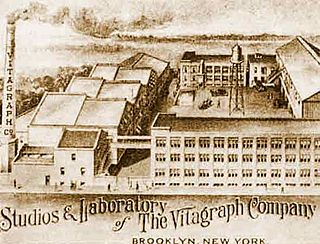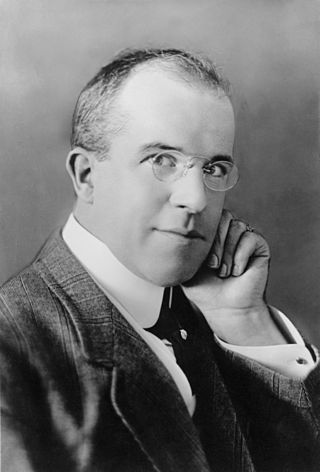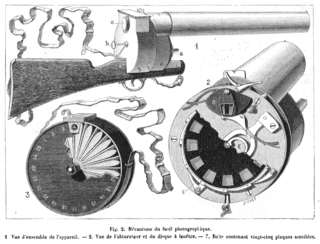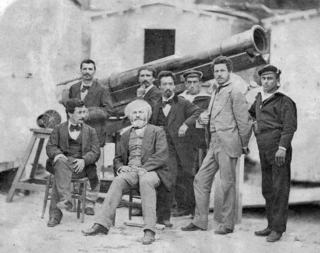Related Research Articles

Stop motion is an animated filmmaking and special effects technique in which objects are physically manipulated in small increments between individually photographed frames so that they will appear to exhibit independent motion or change when the series of frames is played back. Any kind of object can thus be animated, but puppets with movable joints or plasticine figures are most commonly used. Puppets, models or clay figures built around an armature are used in model animation. Stop motion with live actors is often referred to as pixilation. Stop motion of flat materials such as paper, fabrics or photographs is usually called cutout animation.
The following is an overview of the events of 1898 in film, including a list of films released and notable births. The Spanish–American War was a popular subject. Several films made by Col. William N. Selig dealt with the subject of war preparations at Camp Tanner in Springfield, Illinois, including Soldiers at Play, Wash Day in Camp and First Regiment Marching.

Vitagraph Studios, also known as the Vitagraph Company of America, was a United States motion picture studio. It was founded by J. Stuart Blackton and Albert E. Smith in 1897 in Brooklyn, New York, as the American Vitagraph Company. By 1907, it was the most prolific American film production company, producing many famous silent films. It was bought by Warner Bros. in 1925.

James Stuart Blackton was a British-American film producer and director of the silent era. One of the pioneers of motion pictures, he founded Vitagraph Studios in 1897. He was one of the first filmmakers to use the techniques of stop-motion and drawn animation, is considered a father of American animation, and was the first to bring many classic plays and books to the screen. Blackton was also the commodore of the Motorboat Club of America and the Atlantic Yacht Club.
The silent age of American animation dates back to at least 1906 when Vitagraph released Humorous Phases of Funny Faces. Although early animations were rudimentary, they rapidly became more sophisticated with such classics as Gertie the Dinosaur in 1914, Felix the Cat, Oswald the Lucky Rabbit, and Koko the Clown.

The term beta movement is used for the optical illusion of apparent motion in which the very short projection of one figure and a subsequent very short projection of a more or less similar figure in a different location are experienced as one figure moving.

Étienne-Jules Marey was a French scientist, physiologist and chronophotographer.

Laurence Norwood Trimble was an American silent film director, writer and actor. Trimble began his film career directing Jean, the Vitagraph Dog, the first canine to have a leading role in motion pictures. He made his acting debut in the 1910 silent Saved by the Flag, directed scores of films for Vitagraph and other studios, and became head of production for Florence Turner's independent film company in England (1913–1916). Trimble was most widely known for his four films starring Strongheart, a German Shepherd dog he discovered and trained that became the first major canine film star. After he left filmmaking he trained animals exclusively, particularly guide dogs for the blind.

Jean, also known as the Vitagraph Dog (1902–1916), was a female collie that starred in silent films. Owned and guided by director Laurence Trimble, she was the first canine to have a leading role in motion pictures. Jean was with Vitagraph Studios from 1909, and in 1913 went with Trimble to England to work with Florence Turner in her own independent film company.

The chronophotographic gun is one of the ancestors of the movie camera. It was invented in 1882 by Étienne-Jules Marey, a French scientist and chronophotographer. It could shoot 12 images per second and it was the first invention to capture moving images on the same chronomatographic plate using a metal shutter.
The Humpty Dumpty Circus is a lost short stop-motion trick film directed by J. Stuart Blackton and Albert E. Smith, the Anglo-American founders of Vitagraph Studios. There are no known surviving copies.

Albert Edward Smith was an American stage magician, film director and producer, and a naturalized American. He founded Vitagraph Studios with his business partner James Stuart Blackton in 1897.

The Janssen revolver was invented by the French astronomer Pierre Jules César Janssen in 1874. It was the instrument that originated chronophotography, a branch of photography based on capturing movement from a sequence of images. To create the apparatus Pierre Janssen was inspired by the revolving cylinder of Samuel Colt's revolver.

The Airship, or 100 Years Hence is an American adventure comedy-drama silent short film written, produced and directed by J. Stuart Blackton. The film stars Blackton and Florence Lawrence. It was released on April 25, 1908 by The American Vitagraph Company; a partial print of The Airship, or 100 Years Hence is preserved in the Paper Print Collection. The Airship, or 100 Years Hence advertised that it would be "a forecast of a probable means of air navigation in the coming century."

The Haunted Hotel is a 1907 American silent comic trick film written, produced, and directed by J. Stuart Blackton. One of the oldest surviving animated films, it combines live action and stop motion to animate objects.
Events in 1941 in animation.
Events in 1881 in animation.
Events in 1876 in animation.
Events in 1874 in animation.
References
- ↑ Exner, Sigmund (1875). "Über das Sehen von Bewegungen und die Theorie des zusammengesetzten Auges in". Sitzungsberichte der Mathematisch-Naturwissenschaftlichen Classe der Kaiserlichen Akademie der Wissenschaften. V.71-72: 363. Retrieved 2020-12-12– via HathiTrust.
- ↑ Anderson, Joseph; Anderson, Barbara (1993). "The Myth of Persistence of Vision Revisited". Journal of Film and Video. 45 (1): 3–12. JSTOR 20687993.
- ↑ "Revolver fotográfico | IDIS". proyectoidis.org. Retrieved 2018-11-30.
- ↑ Herbert, Stephen (1996). Who's Who of Victorian Cinema. British Film Institute.
- ↑ "Étienne Jules Marey" (PDF). Retrieved 28 June 2024.
- ↑ "Rifle fotográfico". 9 September 2008.
- ↑ "Commodore Blackton, Who Went from Riches to Relief, Dies at 66". Variety . August 20, 1941. p. 4.
- ↑ "Blackton, Pioneer In Movies, Dies, 66. Ex-Commodore of Atlantic Yacht Club Here. Is Victim of Auto Accident. A Founder Of Vitagraph. Producer of 'Black Diamond Express' Thriller. Began as Marine Artist". New York Times . August 14, 1941. Retrieved 2014-12-06.
- ↑ "J. Stuart Blackton's Condition Is Critical". Motion Picture Daily. 13 August 1941. Retrieved 3 September 2014.
- ↑ "Blackton Services Tomorrow in L.A." Motion Picture Daily. 15 August 1941. Retrieved 3 September 2014.
- ↑ Newsday
- ↑ Kahle, Paul. “The Arabic Shadow Play in Egypt.” The Journal of the Royal Asiatic Society of Great Britain and Ireland, no. 1, 1940, pp. 21–34. JSTOR, http://www.jstor.org/stable/25221591. Accessed 10 Mar. 2023.
- ↑ Milwright, Marcus. “ON THE DATE OF PAUL KAHLE’S EGYPTIAN SHADOW PUPPETS.” Muqarnas, vol. 28, 2011, pp. 43–68. JSTOR website Retrieved 10 Mar. 2023.
- ↑ Black, Matthew (1966). "Paul Ernst Kahle, 1875–1965" (PDF). Proceedings of the British Academy. 51: 485–495.
- ↑ Jouvanceau, Pierre (2004). The Silhouette Film. Pagine di Chiavari. trans. Kitson. Genoa: Le Mani. ISBN 88-8012-299-1.
- ↑ "Albert Smith, 83, Film Pioneer, Dies. Inventor of Vitagraph Was Co-Founder of Firm That Achieved Early Success". The New York Times . 3 August 1958. Retrieved 2014-12-06.
Albert E. Smith, a pioneer of the film industry, died last night in his home. ...
- ↑ Plaque #2068 on Open Plaques
- ↑ McKernan, Luke. "Albert Edward Smith". Who's Who of Victorian Cinema. Retrieved 9 December 2013.
- ↑ Ken A. Priebe, The Art of Stop-Motion Animation, Boston, Massachusetts: Thomson Course Technology PTR, 2007, ISBN 9781598632453, p. 9
- ↑ Nichola Dobson, The A to Z of Animation and Cartoons, Lanham, Maryland: Scarecrow, 2009, ISBN 9780810876231, p. xxiv
- ↑ Crafton, Donald (2014-07-14). Emile Cohl, Caricature, and Film. ISBN 9781400860715.
- ↑ Giesen, Rolf (2018-09-27). Puppetry, Puppet Animation and the Digital Age. ISBN 9781351209298.